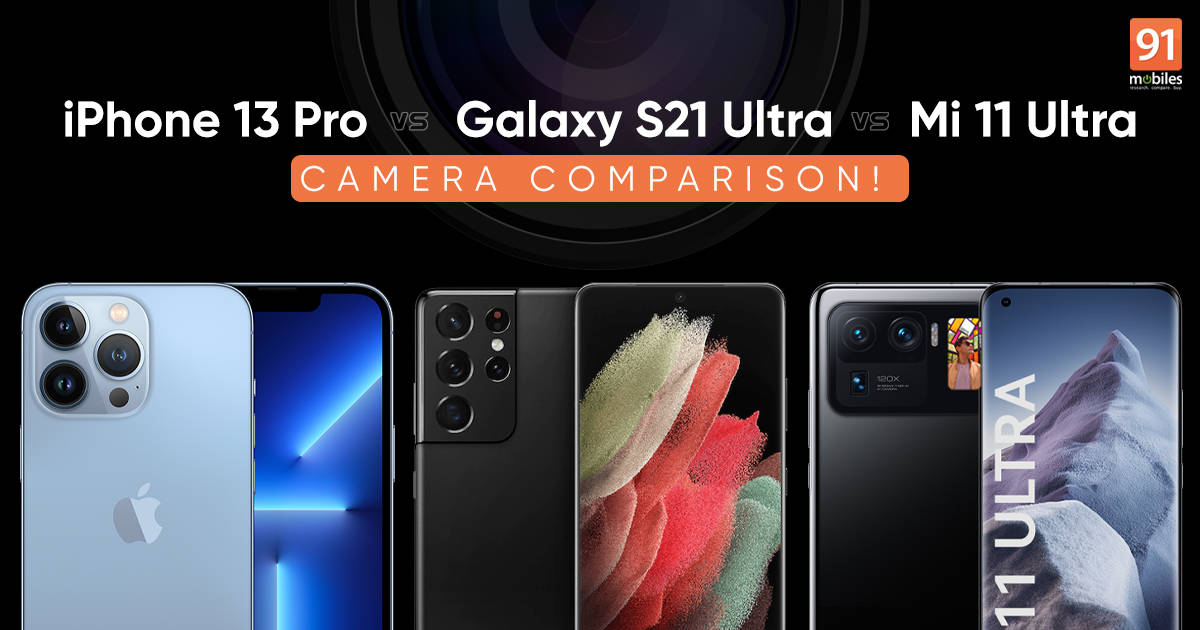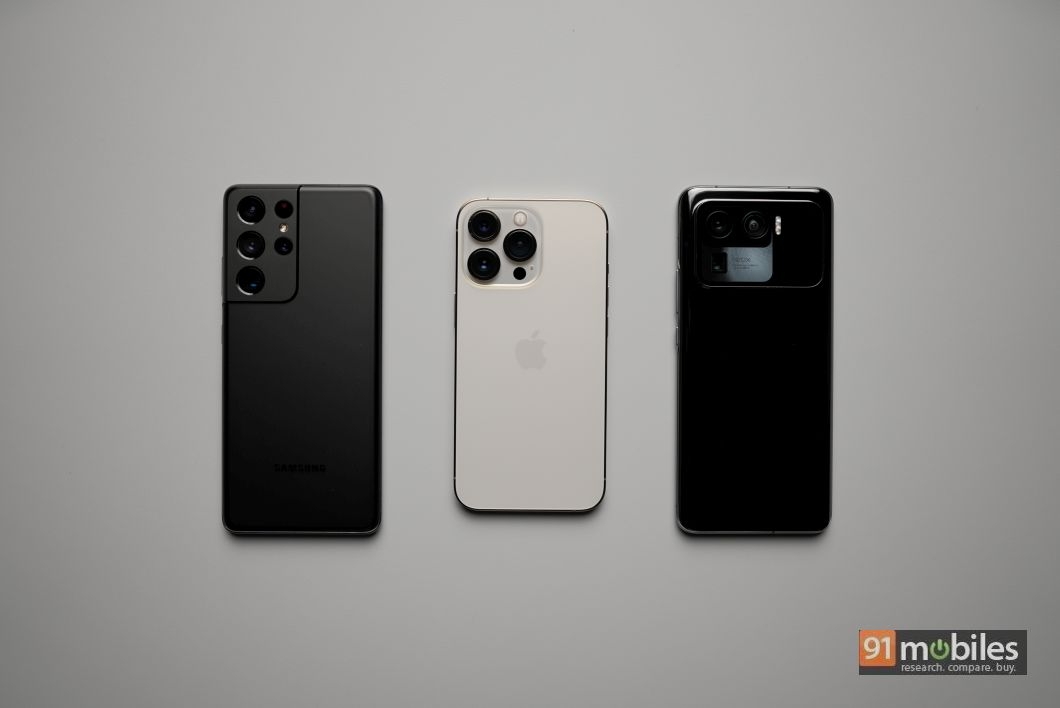Video: Apple iPhone 13 Pro vs Xiaomi Mi 11 Ultra vs Samsung Galaxy S21 Ultra camera comparison

Apple recently took the wraps off the iPhone 13 lineup and in doing so, the company indubiously shuffled the power rankings for the best camera phones in the market. So, how does the latest iPhone 13 Pro stack up against Android heavyweights like the Xiaomi Mi 11 Ultra (review) and the Samsung Galaxy S21 Ultra (review)? To find out, I pit the trio against one another across a variety of shooting scenarios, and in this article, I’ll walk you through my findings and crown a winner. Do refer to the video appended below for more details and insights. However, to keep things short and to the point, I’ll sum up my observations from the video in bullet points below.
Before we get on with the camera comparison, let me get you up to speed on the smartphones’ camera specs. Let’s start with the Xiaomi Mi 11 Ultra which is backed by a 50MP main sensor that works alongside a 48MP ultrawide lens and a 48MP telephoto lens with 5x optical zoom. The iPhone 13 Pro, on the other hand, features three 12MP sensors including a wide, an ultrawide, and a 3x telephoto lens. As for the S21 Ultra, the device makes use of a 108MP main sensor which works in tandem with a 10MP 3x telephoto lens, a 10MP 10x telephoto lens, and a 12MP ultrawide angle shooter. With the specs out of the way, let’s take a closer look at the three phones camera performance –
- It should come as little surprise that the iPhone 13 Pro, the Mi 11 Ultra, and the S21 Ultra can put forth appealing photos during the day. In fact, you’ll be hard-pressed to find faults with the output from any phone’s main camera, especially when there’s ample light around. However, I noticed that the Mi 11 Ultra’s 50MP GN1 sensor consistently yielded sharper images. In fact, at a closer crop, the handset even retained more details than competing devices. That said, the iPhone 13 Pro’s images looked nicer, which can be accredited to the realism in the shots. On the flip side, the S21 Ultra’s oversharpened images did leave a little to be desired. So, while all three phones are, for the most part, neck and neck, I’d recommend users looking to maximise the details in their photos pick up the Mi 11 Ultra. On the other hand, if you aren’t bothered by the minute differences in sharpness and textures at an extremely close crop, you’d be better off with the iPhone 13 Pro.

- The Mi 11 Ultra has a fantastic ultra-wide angle sensor too. In fact, both, the iPhone 13 Pro as well as the S21 Ultra cannot hold a candle to Xiaomi’s offering in this particular scenario. Be it the corner details, or the sharpness towards the centre of the frame, the Mi 11 Ultra’s wide-angle sensor completely blew the competition out of the water. Now, credit where credit’s due, there’s minimal colour temperature disparity when switching between the standard and the wide-angle lenses on the iPhone 13 Pro. But, it’s not enough to warrant a win against the Mi 11 Ultra, which yielded superior details and better textures across the board.
- The Galaxy S21 Ultra is no slouch either, mind you. In fact, the handset is still the ‘zoom king’ in my books. Shots snapped at 3x look equally good from the S21 Ultra and the Mi 11 Ultra’s sensors, with the iPhone 13 Pro struggling to resolve distant objects. However, unlike the competition, the S21 Ultra can also snap crisp images at 10X zoom too.
- The iPhone 13 Pro is a notch above the competition when clicking portrait images. For one, the handset reciprocates the subject’s skin tone the best. Upon closer zoom, I noticed that images from the S21 Ultra looked – for the lack of a better word – pale. The Mi 11 Ultra, on the other hand, rendered the composition dramatically and darkened the subject’s skin tone as well as the colour of the shirt to make the photo pop.
- In terms of low light, Apple’s iPhone 13 Pro managed to snag the lead yet again. I clicked two different sets of shots with the three devices (with and without night mode) and the iPhone 13 Pro’s composition wooed me away. The smartphone’s sensor had a lid-on lens flaring the best in the first photo. In the second shot, the handset retained the most sharpness at a closer crop which is evident if you look at the flower pot towards the centre of the frame, or the reflection of the cars in the windows.
- As for videos, all three phones net compelling 1080p 60fps footage. However, the 13 Pro’s Cinematic video mode is a thing of beauty and should come in handy when you want to dynamically adjust the focus between two subjects. Heck, you can even edit the video later and change the focus points accordingly. Of course, you’ll find a treasure trove of enticing video features on the S21 Ultra and the Mi 11 Ultra too. In fact, unlike the iPhone 13 Pro, both the Androids can shoot videos in 8K resolution. That said, I doubt many folks would be able to make the most of 8K footage, seeing how 8K monitors and TVs are far and few in between.
- Lastly, let’s take a look at the selfies, and here, the iPhone 13 Pro managed to outshine the competition yet again. To be fair, the selfies from the S21 Ultra as well as the Mi 11 Ultra aren’t all that bad. In fact, all three phones net similar results when clicking portrait selfies and outputted an indistinguishable blur effect. However, the 13 Pro’s selfie was the most lifelike.
To conclude, the iPhone 13 Pro wins the most bouts in this camera comparison and correspondingly, is the most prolific shooter of the lot. However, that’s not to say that the S21 Ultra and the Mi 11 Ultra are bad camera phones. In fact, if you rely heavily on a phone’s telephoto sensor (like I do), then you’ll find the S21 Ultra to be the best fit for you. On the flip side, if you tend to crop your images before posting them, then the Mi 11 Ultra’s detail-laden stills will be to your liking better.
The post Video: Apple iPhone 13 Pro vs Xiaomi Mi 11 Ultra vs Samsung Galaxy S21 Ultra camera comparison first appeared on 91mobiles.com.
https://ift.tt/3isepUz
https://ift.tt/3uFnK0h




No comments